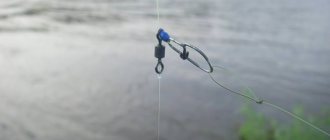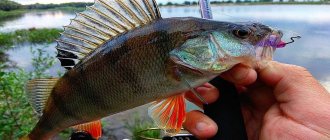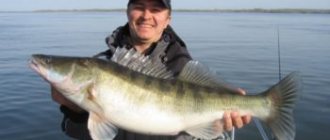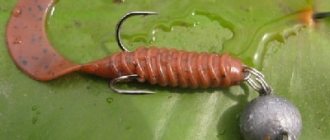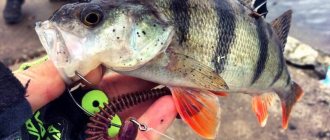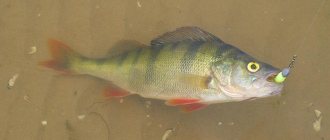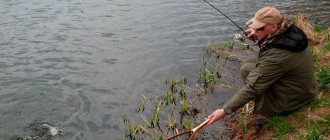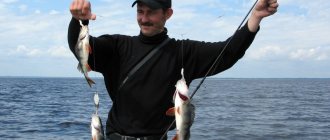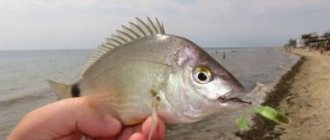To catch perch on a retractable leash, you will need a jig spinning rod, braided line and a set of small twisters up to 3 cm in length. Select a small pond with perch and go to its beginning, to the place where a small river flows. Here the water is rich in oxygen, and perch loves such places. Detailed fishing instructions are in our article.
A retractable leash is the simplest spaced equipment for spinning fishing. Its advantage is good maneuverability on a bottom littered with snags or stones and with increased vegetation. The bait constantly moves along the bottom, but does not touch it, which protects against snags and additionally contributes to better visibility for the perch.
From the article you will learn how to properly catch a striped predator from the shore and from a boat. Selection of gear depending on the strength of the current, fishing depth, casting distance and weight of baits. In the step-by-step instructions for tying equipment, we examined several methods for making a retractable leash for catching active and passive perch for all cases of spinning fishing.
Find out if perch bites on a spinning rod today
| Winter | December | – In most regions of Russia, any winter month means freezing. Only rivers with a strong current do not freeze; in such places it is quite difficult to catch perch, so the probability of being caught is low. Weak bite is possible in regions with warm climates. |
| January | – Weak bite only on non-freezing rivers in warm regions of Russia and CIS countries | |
| February | – Weak bite | |
| Spring | March | – On non-freezing rivers, the water temperature increases, there may be an increased interest of perch in baits, but the bite is still weak. |
| April | – Weak bite on spinning rods in all regions. In warm regions this is due to spawning, in cold regions it is due to insufficient heat. | |
| May | + The bite is starting. The predator actively takes twisters and vibrotails at dawn and during sunset. | |
| Summer | June | ++ Active biting throughout the day. In hot years in June, the bite persists only in the early morning and during sunset. |
| July | + Good bite, even despite the heat. But perch doesn’t catch well during the day in almost any month. | |
| August | ++ Strong bite. The water temperature begins to drop little by little and the bite can be observed for a longer period of time, not even in the late evening and morning until lunchtime. | |
| Autumn | September | + Strong bite, but not like that of pike or pike perch. |
| October | – Weak bite is associated with cold weather. If you are targeting perch, try to look for it in deep holes in any of the cold months. | |
| November | – Same as in October – weak bite or lack thereof. |
Bait selection
Twisters
Most often, twisters are used for bait on a retractable leash. On average, the length is chosen from 2 to 3 cm. It is recommended to use a small offset hook (for example, No. 9 in the domestic classification). Choose a hook with a long enough shank and a large enough distance between the shank and the sting to get a good hook on the perch. The offset type of hook is good for mounting bait using the non-hooking method.
What color should I choose a twister? It is important to take weather conditions into account. If it's cloudy or muddy water, take colorful, fluorescent baits. When the water is clear and the sun is shining, choose a bait of natural colors. There is an opinion that perch has a greater preference for red and orange shades.
Other types of baits
Vibrotails . This bait is used less often, since without a special load it does not hold a constant game and makes unnecessary movements. As a result, it becomes not very similar to a real small fish.
Lightweight spinners. This type of bait is used very rarely. Despite such good quality as the ability to make amplitude vibrations, they cannot surpass a twister.
Wobblers . Of all the variety of types of wobblers, the best option is floating ones, which have a diving depth of from a meter to one and a half meters. When the fishing line is slowly wound, such a bait floats, gurgles and dives (the faster the pace of the reel, the greater the depth of the dive). If you stop pulling up, it will surface.
Other types of silicone baits (for example, crustaceans, worms, squids, etc.). They are used very rarely by fishermen, as they are unusual for perch, and in some way exotic.
Practice shows that the bait should resemble a small fish. And if you fish with a retractable leash, then you are fishing for a sick fish. The majority of baits listed above do not fully meet this requirement.
Tackle
Fishing to catch perch in ponds and small lakes from the shore involves choosing a lightweight Ultralight class rod. Test 0.5-8 g. Length 1.8-2.1 m. When fishing from a boat, the length remains the same, since the class assumes lightness of gear and longer rods capable of working with small weights are simply not needed here.
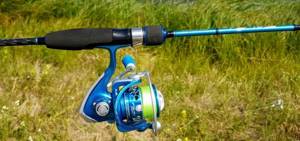
Popular solution for ponds and small rivers: Favorite Blue Bird BB-632UL-S – 1.92m, 1-7g
When fishing in reservoirs, large and medium-sized rivers , where the fishing depth reaches 5 meters or more, there is a medium and strong current and a casting range of more than 50-70 meters - rods of 2 classes are suitable: 7-21 g and 10-40 g. Length 1.8 -2.1 m when fishing from a boat and 2.4-2.7 when fishing from the shore. The more difficult and rough the fishing conditions (depth, range, current, wind) - the heavier the spinning rod you will need.
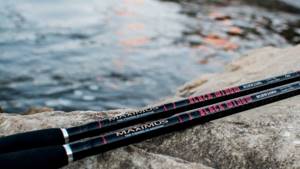
Jig spinning rod for perch for fishing from the shore: Maximus Black Widow MSBW26ML – test 4-18 g, length 2.58 m
Coil. The spinning rod must be equipped with a reel of a suitable class.
| Test | Reel Spool Size |
| 0.5-7 g | 1000 |
| 7-21 g | 1500-2000 |
| 10-40 g | more than 2500 |
Use the data in the table as a guide. How to interpret coil size? Very easy. Size 1000 means that the spool will hold 100 meters of fishing line with a thickness of 0.1 mm.
Easy option:
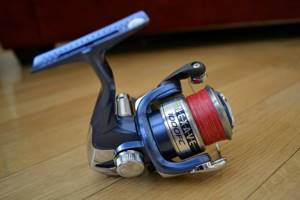
Shimano Nexave 1000 FB2
For medium and heavy class spinning rods:
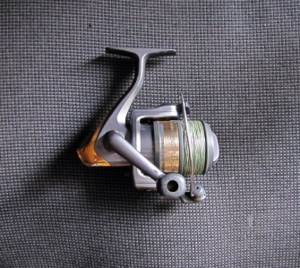
Daiwa Regal 2500
Fishing line. When fishing with a retractable leader, a constant connection between the tip of your rod and the sinker on the other side of the line is extremely important. At every moment of the stepped retrieve, you should feel the equipment - where it is, whether there is contact with the ground, whether the bait is moving downhill or, on the contrary, going uphill. All this is possible only when using a braided cord. Braid diameter: 0.11-0.14, no more needed. The thick cord does not allow long casts of light baits.
Leash. In addition to the classic jig rig with a jig head, we will also need a piece of fluorocarbon line (fluorocarbon line). It has the properties of invisibility in water, is harder to the touch, has practically no memory of deformation, but it also has a drawback. It can withstand less load than conventional monofilament fishing line. Hence the requirement for its thickness arises. The minimum diameter that we recommend for fishing is 0.25 mm, but 0.31 mm can be used. The Sunline company produces good, pure fluorocarbon with maximum breaking strength, but there are other companies with high-quality products of this type.
We proceed to the manufacture of spaced equipment of the classical type.
What is a perch diverter leash?
There are several classic types of mounting such a leash, which are constantly being improved. Let's look at the general view of equipment often used by spinning fishermen.
The simplest installation is “Moscow equipment”. To make equipment and several carabiners, a 4-10 gram pear-shaped sinker, a fluorocarbon leader, a hook, preferably offset, silicone or other bait.
The simplest equipment is made using the loop method. On the main line of the tackle, usually braided 0.12-0.25 mm, a loop is made, to which a sinker of 4-18 grams is attached. At a distance of 20–30 centimeters from the load, a leash with bait is attached to a loop on the braided line; preferably, it should be made of 0.14–0.29 mm fluorocarbon. Its length is from 50 centimeters to 1−1.2 meters. For equipment, you can additionally use regular or T-shaped swivels.
The sliding and blind versions of the equipment differ in that in the first version the load with the leash can move freely along the main line, and in the second it is attached using a T-swivel or in a loop.
Fishing for perch with a diverter is effective both with traditional types of installation and with new methods of equipment. Fishermen often make changes: they place a foam ball at the hook with the nozzle, which is necessary so that the bait falls to the bottom more slowly; the length of the leash is constantly changed during fishing, performing various manipulations with baits and weights.
Where do they catch
We looked through the fishermen's reports and found points on the map where we caught perch on a retractable leash.
Correct installation of a diverter leash on a perch
The classic diverter leash diagram is shown in the photo below:
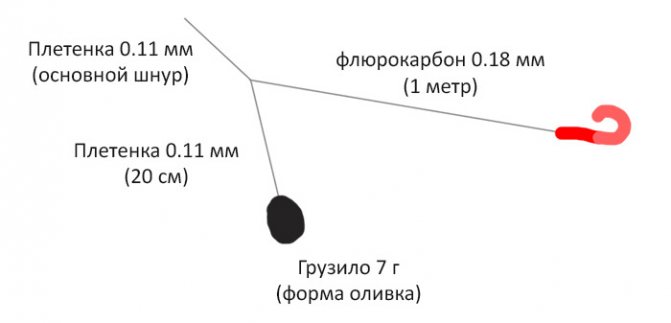
Step-by-step instructions for knitting a rig:
In total, 3 elements are involved in the rig: the main line, a fluorocarbon leader, a hook, a swivel with a clasp and an olive-shaped sinker (or any other longitudinal shape). Let's start installing all the necessary elements.
- At the end of the fishing line, tie a swivel with a clasp. Knot – double clinch or grinder. The swivel will help you quickly change sinkers of different weights depending on the fishing conditions. But you can do without it, then just tie the sinker with the same knot.
- Tie a piece of fluorocarbon fishing line 1.5 meters long 15-20 cm from the sinker higher towards the tip of the rod. This will be our leash, on which the bait will then be attached. A figure eight is ideal as a knot.
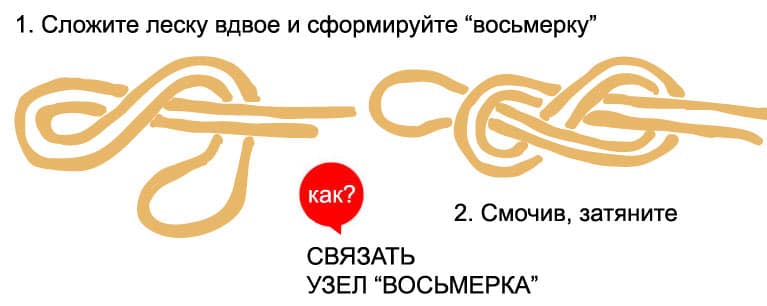
- There are several ways to make a rig leader. The length of the leash can vary, but is usually 1 meter. You can either shorten or lengthen it up to 1.5 meters. The longer the leash, the smoother the action of the bait will be, the shorter it is, the more movements the twister or vibrating tail will make following the sinker. Lengthen the leash if the bite is bad and the perch is not active.
- Having measured the required length of the leash, tie an offset hook with any knot for hooks.
- Attach a twister or vibrating tail to the hook according to the following instructions:
Correctly installing the diverter leash is half the success. In the following instructions you will learn how to choose the right silicone for still water and when fishing in currents, as well as depending on the size of the perch.
A retractable leash involves fishing with rubber. But there are options to assemble the equipment with a wobbler or bombard. As a wobbler, use baits with neutral buoyancy and a depth of up to half a meter. And bombarda involves fishing in the upper layers of water, this is a topic for a separate article. Sbirulino is attached instead of a sinker.
Features of using the “retractable leash” equipment: fishing technique and tactics
The essence of fishing in this way comes down to the fact that tapping the weight on the bottom and playing the bait attracts fish. When fishing, step-by-step wiring works best, which gives the bait a certain intensity in the game. When retrieving in stages, the bait is lifted from the bottom by jerking the rod or by accelerating the winding of the reel, then again it is allowed to fall to the bottom. You can use double undermining by swinging the tip of the rod. With active biting, you need more aggressive wiring, with passive biting - soft and smooth.
There are other types of wiring:
- Uniform wiring is used a little less frequently than stepped wiring, but is sometimes just as effective. With this type of wiring, you can add swaying of the rod and take short breaks.
- Dragging along the bottom is also rarely used. With this type of wiring of the outlet leash, the load of the equipment moves slowly along the bottom with short stops. The bite occurs most often when the rotation of the reel slows down.
You can experiment and use various elements of different types of tackle wiring, change the size and installation of the leash equipment.
When fishing in reservoirs without current, all existing equipment and various types of wiring are used. In the lake you don’t have to choose the direction of casting. It doesn't matter if it's upstream or against it. There are no strong currents on the lakes, so on stagnant bodies of water you just need to throw the tackle at the point that seems more promising.
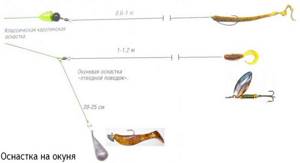
Due to the lack of current, all animation of a silicone or other bait falls entirely into the hands of the spinning angler. And its animation in a still body of water needs to be given more attention, using different types of fishing gear. A technique that is effective on a lake is a long-term play with bait in one place, which cannot be used on rivers.
The attack of the perch occurs mainly at the moment of pause. When biting, the hook should be immediate, but not strong. A very strong hooking tears the lips of the fish, and consequently leads to loss of catch.
Selecting a twister/vibrating tail
Lures for the retractable leash are silicone twisters and vibrotails. The first one has a bright high-frequency play and looks more like a long worm or squid. The vibrating tail is a prototype of the fry, which also plays with its tail at a fairly high frequency, but is still inferior to the twister in vibration frequency. You need to know that perch loves more frequency vibrations (the more vibrations per second, the better).
Twisters are the choice for fishing in still water. But vibrating tails are also quite suitable, although they work better in the current. And with a weak bite they are even more preferable!
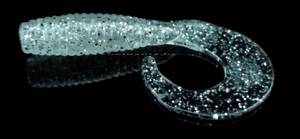
As is the case with the top baits for pike-perch, the Crazy Fish Angry Spin 2 works just as well on perch simply because the action of the tail is very amplitude and high-frequency

Lunker City Monkey Grub 76 – a good twister for medium and large perch
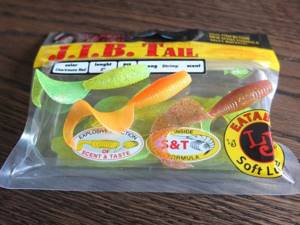
Lucky John JIB Tail is a favorite for bitten tails, but the bait is worth it
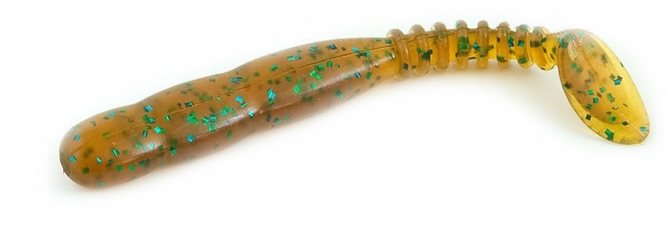
Reins Rockvibe Shad 2 – long tail for high-frequency play, ideal vibrating tail for catching perch in currents
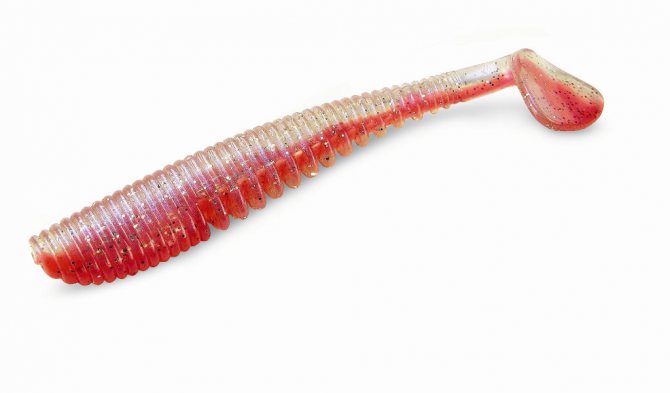
Pontoon 21 Homunculures Awaruna 1.5 – excellent vibrating tail for small perch made of soft rubber
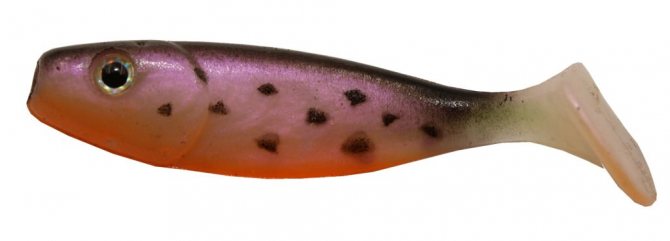
An example of a weaker Chinese-made vibrating tail with inexpressive play. But even with it you can actively catch perch, provided the correct fishing technique is used.
Attention! Select the size of the bait in relation to the size of the fish's mouth. The perch does not have such a large mouth, and the twister or vibrotail should easily fit into the mouth, otherwise there will be a lot of idle bites. If you fish on a pond or small river, where the size of perches is no more than 100-200 g, use small-sized twisters and vibrotails, even non-brand ones (2-3 cm is enough). This will bring you more realized bites than branded Reins 4-5 cm long, but with many idle hooks.
Seasonal nuances of using diverter leashes
Catching perch on a retractable leash has its own characteristics at different times of the year.
- In the spring, during the zhora period, the diverting leash can amaze with its effectiveness. Different rig options are equally effective at catching perch in different conditions. At the end of spring, when aquatic vegetation appears, it is advisable to equip the leash with offset hooks and a streamlined weight resembling a Tyrolean stick.
- Summer is not the most catchy time for a diverting leash. However, even at this time of year it gives its results. During this period, perch feeds in the upper and middle layers of water; activity manifests itself in the morning and evening hours. It is especially productive to use a diverting leash in the summer on cloudy, cool days, when perch activity is quite low.
- In the fall, fishing for perch on a retractable leash is especially productive. During this period, you need to experiment with attachments and wiring. When fish activity is low, the fishing speed should be reduced. If the bite is normal, it is necessary to use fast, aggressive options.
Choosing a fishing spot
If you are going to catch perch on a retractable leash, keep in mind that perch loves fresh water. When fishing on a pond, go to its beginning, where the river flows into this very pond. This is a guaranteed spot with plenty of bass. When fishing on a river, choose a steep bank rather than a flat one. Here the depths of 2-5 meters are much closer, where the perch stands.
When fishing on a reservoir, the same rule applies - choose a steep bank and try to cast as far as possible. Significant depth and the presence of depth differences are possible 50-70 meters from the shore, so an increased casting range and the use of sinkers of 14-18 g are quite justified.
Video about underwater filming of a perch and its reaction to a retractable leash:
Here you can clearly see the action of the bait in the water on a lead rig.
Advantages of using a retractable leash when fishing for perch
Perch is caught on a retractable leash almost always and everywhere, which is due to some advantages of this type of equipment:
- Using a leash makes it possible to lead the bait slowly. It is constantly located just above the bottom to avoid numerous snags and to fish difficult snags and vegetation-covered areas.
- For fishing with this tool, a huge number of silicone baits are suitable as attachments: vibrating tails, twisters, worms.
- A bait that is not weighted with a jig head creates intense movement, which attracts perch and other predators, and sometimes peaceful fish. The gear provides the opportunity to fish the lower deep layers of a reservoir with light, small baits.
- A retractable leash makes it possible to vary a large number of types of leads, work at different casting distances, different depths, and fish on bodies of water with different current intensities.
- This type of equipment works great in cold water. Catching perch on a retractable leash is effective in the fall. At this time of year, it is not uncommon to catch large striped predators.

This “smart” tackle often helps out in case of complete lack of bite, when it seems to the angler that there are no fish in the reservoir. If there are no other bites besides light pokes, it’s time to put the heavy jig heads back in the bag and put on a “retractor” with the correct attachment.
Fishing technique + video
Fish the shore gradually moving to the side, casting every 10-20 meters. Make 2-3 casts in different directions, and then, if you don’t find any bites, move again.
- The ideal bait retrieval when fishing with a retractable leash is a stepped retrieve.
- You cast the rig to the maximum distance, or to the distance required for your fishing conditions.
- Close the line guide of the reel to stop the line from flowing from the spool.
- Place the spinning rod slightly to the side and keep the line taut while looking at the tip of the rod.
- As soon as the line slacks, it means the bait is on the bottom, it’s time to start reeling.
- Stepped retrieving involves 1-4 turns of the reel handle and a pause until the load falls to the bottom again, and then again making those same 1-4 turns.
We recommend watching a video about catching perch in practice:
We recommend experimenting with the number of coil revolutions, speed of rotation, and pause duration. You should start with two quick turns. Make several casts using only this type of wiring and if it doesn’t work, try increasing the number of revolutions, reducing the speed of revolutions, and making longer pauses. That's all the practice is.
Advantages of a retractable leash
The load Tyrolean stick is an integral part of the tackle, providing excellent cross-country ability.
- An easy to learn method. It can be installed by a beginner in a few minutes and does not require any special skills or knowledge.
- Cheap and accessible to everyone. If the fisherman already has a spinning rod, a reel and fishing line, then all that remains is to add 1 swivel, 1 hook and a cheap vibrating tail, tie it all together in 2 minutes on the shore and you can start catching perch. The cost is extremely low compared to fishing with a wobbler.
- Versatility. Can be used on any body of water in any weather. It is not afraid of either tree debris at the bottom or any rare obstacles; its cross-country ability is excellent.
- All-season. You can use a diverter leash throughout the year if the pond does not freeze in winter. It is actively used in spring, summer and autumn, as an alternative to any other methods of catching a striped predator.
- Catches any fish. Perch is not the limit; pike perch are also great to catch. At the same time, the sizes in the catch are different, both small and trophy specimens.
Fishing
Perch is a fish with very soft lips and the hook needs to be done with a very small amplitude, just twitching the rod a little to feel the tension of the line over half a meter of sharp wiring. This is enough to not tear off the perch’s lips and keep it on the hook. Not hooking at all is wrong; you risk losing the fish when fishing. This predator really likes to resist by wriggling with its entire massive body, so getting off the hook if the hook is not strong enough is very likely. Don't let this happen, a small hook will be enough.
Otherwise, fishing is not difficult - uniform rotation of the reel and bringing the perch to the tip of the rod at 1.5-2 meters, so that by lifting the tip of the rod up you can easily pick up the perch.
That's all. We figured out how the diverting leash works and how to fish with it. Please ask your questions and share your experiences in perch fishing in the comments. You are interested in everything - fishing spots, perch behavior characteristics, choice of bait and your fishing technique.
Lures for perch
For hunting on a retractable leash, many ingenious baits made of edible and inedible rubber have been invented:
- Oscillators;
- Swimbaits;
- Turntables;
- Surface wobblers;
- Suspenders;
- Foam fish;
- Polyurethane fish;
- Twistors;
- Vibrating tails.
Twisters
The most popular are twisters. This bait works especially well with stepped retrieves. It smoothly goes to the bottom following the sinker. It looks natural, and that’s why it attracts perch so much. To prevent the twister from turning around its axis during wiring, the shank of the hook must be loaded with lead pellets.
For bait, fishermen take small twisters up to 3 cm and a No. 9 hook. The main thing is that its tip does not protrude from under the bait. Otherwise, it will be difficult for the perch to catch on. Which bait color to choose will depend on the conditions and fishing location:
- If visibility is poor, it is advisable to take bait with a bright color.
- If the day is sunny and the water is clear, then take twisters of natural shades with you for fishing.
It is believed that red and orange baits are more preferable for perch. If you use edible rubber, it significantly increases the fish bite. Edible baits made of silicone and rubber are divided into:
- Active;
- Passive.
They are used for:
- Passive rubber - works great in standing water;
- Active - it is advisable to use only on reservoirs with intense currents and when wiring.
In order for edible rubber to attract fish, it is impregnated with attractants.
Wiring when catching perch on a retractable leash, video:
Vibrotails
Vibrotails got their name for a reason.
They have a tail that vibrates, and the silicone figurine itself resembles a fish. This is what attracts them. Vibrating tails have different configurations (round, elongated, narrow, etc.). All models have their own special tail shape. Size and appearance will influence the number of vibrations emitted by the tail in a certain unit of time. Tails can be:
- Without notches;
- With notches;
- Slightly tapered;
- Flattened.
Manufacturers produce vibratortails from edible rubber, and with many different variations of the tail and body. They differ not only in size and color, but also in the softness of the material.
Wobblers
Of the various types of wobblers, we can note two of the best - floating and suspenders. The second option is very similar to a twister; it also behaves in water, during pauses. Just don’t use very deep diving models; the diving depth should be from one to a maximum of two meters.
Wobblers, when slowly winding the line, will quietly swim and dive. The more intense the liner is, the stronger the amplitude of immersion in water will be. If you stop pulling, the bait will immediately jump to the surface.
Lead line
It is imperative to use only braided cord as fishing line. Because monofilament stretches very strongly when tensioned. The jig fishing method involves:
- Constant control over the location of the bait;
- Clear hits of the sinker on the bottom of the reservoir and barely visible bites.
The desired diameter of the braided cord is 0.13-0.16 mm. If a large perch up to two kilograms gets hooked, the line will hold. But if you are an inexperienced braid user, then stock up on monofilament fishing line (nylon). There will be a loss of sensitivity, it cannot be avoided, but there will be less confusion. But once you gain a little experience, this problem will disappear. Only the braid must be of high quality.
Leash
A necessary attribute is a diverter leash. To do this, you will need a fluorocarbon line with a diameter of 0.3-0.4 mm. Its main advantage is its invisibility in a body of water. There is only one flaw, but a significant one - minimal ability to bear the load. To eliminate this shortcoming, this leash thickness will be required.
Techniques and methods of fishing with a retractable leash
The angle of inclination of the rod must be large. The best option is to place it almost vertically. This technique will not only help reduce the number of hooks, but will also ensure that the bait is raised to the desired height. She will be in greater proximity with the fish, and will involuntarily provoke it to bite. The most common wiring methods:
- Measured - not often used by fishermen, but it gives unexpected results. You can set the pace at different speeds. You can try making oscillatory movements with the upper part of the rod.
- Stepping - make several turns of the coil and wait. When the tip weakens i.e. the sinker should sink to the very bottom of the reservoir, and again we make 2-3 turns. Different styles of this wiring will differ only:
- their swiftness;
- number of revolutions.
- The tip of the rod should swing - we wind the fishing line and simultaneously swing the upper tail part of the whip up and down, and slowly first remove the rod from the water and lower it again. This technique will help transform the wiring and increase the bite.
The perch bites between pauses when the bait does not move. This resembles a blow, the main thing is to make a timely strike. And this must be done with a small amplitude, otherwise the fish will break off.
Fishing by season
You can catch perch on a retractable leash all the time in open water. The difference between seasons is in the activity and location of fish in the reservoir.
In summer it is caught throughout the day. The largest number of it is found in shallow water in warm water, but there are medium-sized and small-sized individuals, although there are a large number of them there. Preference is also given to thickets of grass and algae, vegetation windows and reed edges. Trophy specimens sit alone at depth. It is for such perches that fishing with a retractable leash is suitable; it will allow you to cast the tackle far and deliver it directly to the predator.
You can also catch stripers in the spring. After winter it will feed actively.
You should look for it at depth in holes or near them. With gradual warming, it will move to shallow water. It is necessary to monitor the water temperature. In mid-autumn, the bulk will be on the slopes towards deep water. Immediately before spawning, it finally moves to shallow water and stands in the shade of trees and grass. In such places it is easier to use a float rod, since there is no need for long casts.
Contrary to the general opinion that there is no bite during spawning, perch can be caught during this period. The fact is that not all individuals lay eggs at the same time. Fishing activity drops compared to the beginning and middle of spring, but still continues.
Autumn
In autumn, fishing also differs by month. In September, perch activity begins to gradually increase compared to summer. It is located in shallow water, standing in grass and snags, as well as in the shade of thickets of trees. Responds especially to animal baits. The size of the bait often does not matter unless you are fishing with live bait. Even relatively small individuals attack large baits.
By October, a gradual transition to depth begins. During this period of time, nutrition also continues intensively. The perch stands on the edges, the borders of the reeds, the larger ones are slightly closer to the depth, the smaller ones are next to the grass. Therefore, the use of a diverting leash will be the best way to show yourself; its characteristics, like gear, will allow you to fish in both places.
In November the final transition to depth occurs. The fish stands quite a distance from the shore. At this time, preference will be given to heavier spoons and the same “layers”. They will allow you to make fairly long and clear casts. All that remains is to decide on the location of holes and other bottom irregularities necessary for the perch.
You can catch the predator in winter using lures, if the reservoirs are not covered with ice. Fishing is the same as in November. The perch sites remain the same and the fishing gear used is the same.
Types of installation
- In the process of using this or that gear, fishermen are constantly trying to improve the methods of securing a load or bait, while others prefer not to change anything and stick to time-tested methods.
- There are also several options for installing a diverter leash.
- In the first case, both the load and the leash are tied directly to the main fishing line with a distance of 20-30 cm. The option is very simple to implement, without additional fasteners you can assemble it directly while fishing, but there is a high probability that the leash will be wound onto the cord.
- The second method differs only in that the leash is attached through a swivel, which prevents it from twisting. The load is attached through a carabiner, as in other cases.
- For the next execution, you will need two pieces of fishing line, one for the load (20-30 cm), and the second for the bait (1-1.2 m). Both pieces are attached to each other via a swivel. A sinker is attached to the end of the short one, and a nozzle is attached to the long one. A carabiner is attached to the end of the main cord, which clings to one of the ends of the swivel (from the load side).
- In the fourth option, you will need three pieces of fishing line, two the same as in the previous case and one short, no more than 15 cm, as well as two swivels. A swivel is threaded into the shortest section of the fishing line, with a lead attached. A second swivel with a weight is tied to one end of the fishing line, and a loop is made at the other for attachment to the main fishing line. Thus, it turns out that the leash with the bait will slide along this segment, and the bait will additionally move in the water column.
- You can also attach it through a triple swivel; in this case, the main line and sinker leader are tied to parallel eyes, and the outlet leader is tied to the perpendicular one.
